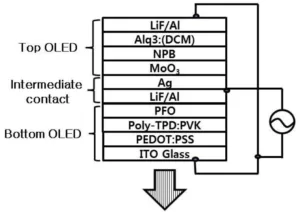Although there are a number of ways to produce a multicolor OLED display, existing technologies either do not allow electrical control of the emission colors or require additional manufacturing steps. This issue is being addressed by research in Korea.
A project is being undertaken by Seok-Hwan Chung and Hee Yeon Noh at the Nano-Energy Convergence Research Division within the Daegu Gyeongbuk Institute of Science and Technology (Daegu, South Korea). The researchers are investigating an approach based on stacked OLED devices.
A recent article on this topic by the researchers is entitled “Color-tunable stacked organic light-emitting diode with semi-transparent metal electrode.” It was published in Vol. 6, No. 9, Sep. 1, 2016, Optical Materials Express, pp 2835-2839 a copy of which can be found on-line.
The new device has two terminals and is illustrated in the figure below.
The top electrode is directly connected to the bottom electrode. A DC or AC voltage is applied between the top and bottom electrodes and the intermediate electrode.
The intermediate Al/Ag dual metal electrode is semi-transparent and allows high optical transmission as well as high conductivity. Note that the intermediate electrode is used as a cathode for the bottom OLED and as an anode for the top OLED. The MoO3 layer is a buffer and serves to substantially reduce the threshold voltage by lowering the injection barrier. It also minimizes chemical reactivity between the metallic electrode and the layer of organic material NPB.
The bottom structure was fabricated at room temperature by spin coating a polymer solution while the top structure was fabricated utilizing a vacuum deposition process. Part of the reason that these fabrication process are compatible is that thermal evaporation of the metal electrode causes little damage to the organic materials. Further details on the materials and processes used in fabricating the device can be found in the Optical Materials Express article.
Having produced prototype devices, the researchers then investigated their electrical and optical properties. A great deal of detailed information on the characteristics of the device can also be found in the article.
The prototype device demonstrated that the top and bottom OLEDs could be independently addressed by switching the polarity of the voltage applied to the two terminals. In addition, the color emitted by the stacked OLED devices could be tuned between green and blue or red and blue by adjusting the offset of the alternating current applied to the stacked OLED devices. Adjusting the voltage offset adjusts the relative amount of different color light emitted from the top and the bottom OLED devices. It was found that the alteration of the color coordinates occurs along a straight line on a CIE chart. The researchers commented that, unlike other color tuning methods, the usage of an AC voltage is readily compatible with household power supplies.
The researchers have stated that future work will focus on lowering the turn on voltage, enhancing the coupling of the light output and “engineering the CIE coordinates for tuning colors through white emission.” -Arthur Berman
Daegu Gyeongbuk Institute of Science and Technology, Seok-Hwan Chung, [email protected]

